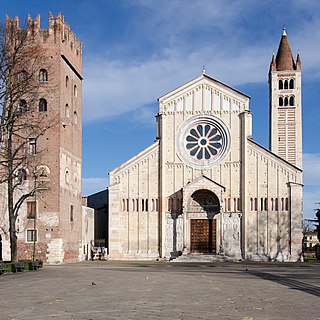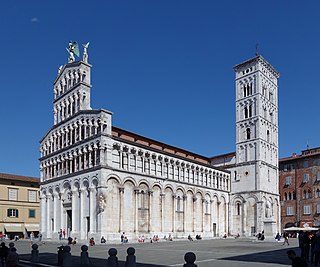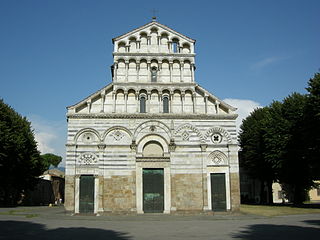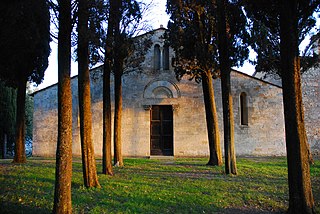

San Giusto is a church in Lucca, Tuscany, central Italy. Built over a pre-existing church, it dates to the second half of the 12th century. Its titular is the 12th century Italian, Giustino Salce, whence the name "San Giusto".


San Giusto is a church in Lucca, Tuscany, central Italy. Built over a pre-existing church, it dates to the second half of the 12th century. Its titular is the 12th century Italian, Giustino Salce, whence the name "San Giusto".
The present building has a nave and two aisles with apses. The façade has a mixed decoration, with white and black stripes in the upper part, forming two small superimposed loggias at the top.
The central portal was made by Guidetto's workshop, and, among the other details, includes two twisting atlases (one now partly missing) supporting two protruding lions at the sides of the lunette. The rest of the decoration has vegetable motifs or fantastic creatures. The two roots of the internal archivolt (which has black and white rows like in the upper façade) lay on two cubes with masks of Classic origin.
The side portals have less ornate decorations, mostly limited to the capitals and similar to that of the central one. The latter is surmounted by a double mullioned window, while above the side ones are simpler oculi. The apse's exteriors features Lombard bands and two orders of single mullioned windows. The interior was remade during the 17th century in Baroque style.
Coordinates: 43°50′31.12″N10°30′13.24″E / 43.8419778°N 10.5036778°E

The Basilica of Sant' Apollinare in Classe is a church in Classe, Ravenna, Italy, consecrated on 9 May 549 by the bishop Maximian and dedicated to Saint Apollinaris, the first bishop of Ravenna and Classe. An important monument of Byzantine art, in 1996 it was inscribed with seven other nearby monuments in the UNESCO World Heritage List, which described it as "an outstanding example of the early Christian basilica in its purity and simplicity of its design and use of space and in the sumptuous nature of its decoration".

Offida is a comune (municipality) in the Province of Ascoli Piceno in the Italian region Marche, located about 80 km south of Ancona and about 12 km northeast of Ascoli Piceno, on a rocky spur between the valleys of the Tesino and Tronto (south) rivers.

Cremona Cathedral, dedicated to the Assumption of the Blessed Virgin Mary, is a Catholic cathedral in Cremona, Lombardy, northern Italy. It is the seat of the Bishop of Cremona. Its bell tower is the famous Torrazzo, symbol of the city and tallest pre-modern tower in Italy.

The Basilica of San Simpliciano is an ancient Roman Catholic church in the centre of Milan, region of Lombardy, Italy: the church, commissioned by the 4th century bishop St Ambrose, is the second oldest known Christian church with a Latin cross layout. It is dedicated to Saint Simplician, who was Ambrose's successor as bishop of Milan.

The Basilica di San Zeno is a minor basilica of Verona, northern Italy constructed between 967 and 1398 AD. Its fame rests partly on its Romanesque architecture and partly upon the tradition that its crypt was the place of the marriage of Shakespeare's Romeo and Juliet. It stands adjacent to a Benedictine abbey, both dedicated to St Zeno of Verona.

The chiesa di Sant'Anastasia, or the Basilica of Saint Anastasia is a church built by the Dominican Order in Verona, northern Italy. In Gothic style, it is the largest church in the city, located in its most ancient district, near the Ponte Pietra.

San Liberatore a Maiella is an abbey and church in the territory of Serramonacesca, in the province of Pescara, region of Abruzzo, Italy.

San Michele in Foro is a Roman Catholic basilica church in Lucca, Tuscany, central Italy, built over the ancient Roman forum. Until 1370 it was the seat of the Consiglio Maggiore, the commune's most important assembly. It is dedicated to Archangel Michael.

San Paolo a Ripa d'Arno is a Roman Catholic church in Pisa, region of Tuscany, Italy. It is a pre-eminent example of Tuscan Romanesque church architecture. The church is also locally known as Duomo vecchio.

San Sisto is a church in Pisa, Tuscany, Italy.

Santa Caterina d'Alessandria is a Gothic-style, Roman Catholic church in Pisa, region of Tuscany, Italy.

Carrara Cathedral is a Roman Catholic church, dedicated to Saint Andrew, in the town of Carrara, located in central Italy. Most of the exterior, and much of the interior, is covered in the local Carrara marble.

Santa Maria Assunta in Cellole is a church and former pieve located in Pancole, in the municipality of San Gimignano, province of Siena, Tuscany, central Italy. Mentioned for the first time in 1109, it was rebuilt several times between the 12th and 13th centuries, and was consecrated in 1238.

San Giovanni Fuoricivitas is a Romanesque religious church and adjacent buildings in Pistoia, Tuscany, central Italy. The adjective fuoricivitas refers to it location, outside of the first set of city walls, when it was founded during the era of Lombard rule in Italy.

Innichen Abbey is a former Benedictine monastery in Innichen, South Tyrol in northern Italy. Founded in the 8th century, its collegiate church dedicated to Saint Candidus, rebuilt in the 12th–13th centuries, is considered the most important Romanesque building in Tyrol and the Eastern Alps. It is home to a 13th-century sculpture and a fresco cycle from the same age in the dome.

Santa Maria della Pieve is a church in Arezzo, Tuscany, central Italy.

Santa Maria is a medieval church in the comune of Uta, Sardinia, Italy.

Trani Cathedral is a Roman Catholic cathedral dedicated to Saint Nicholas the Pilgrim in Trani, Apulia, south-eastern Italy. Formerly the seat of the archbishop of Trani, it is now that of the archbishop of Trani-Barletta-Bisceglie. Consecrated in 1143, is one of the main examples of Apulian Romanesque architecture.

The church of San Secondo di Magnano is built in a wide open space near the Serra d'Ivrea, not far from the Bose monastic community, in the comune (municipality) of Magnano, Italy. It is one of the most interesting examples of the Romanesque architecture in the Provincia di Biella and the Canavese.
San Lorenzo is a Romanesque-style, Roman Catholic parish church, located in the San Lorenzo di Moriano neighborhood outside of the city of Lucca in Tuscany, Italy.